Who was Princess Diana and what happened on the night of her death?

Who was Diana, Princess of Wales?
Born Diana Frances Spencer on 1 July 1961, her father, Edward John Viscount Althorp, was the only son of the 7th Earl Spencer. Her mother, born Frances Ruth Burke Roche, was the youngest daughter of the 4th Baron Fermoy.
The Spencers had served the Royal Family for generations. Diana's great-grandfather, the 6th Earl Spencer, was Lord Chamberlain to both Edward VII and George V. All four of her great-aunts on the Spencer side became members of the Queen Mother's household and her father was equerry to both George VI and the Queen.
After her father inherited the title of Earl Spencer in 1975, she became known as Lady Diana Spencer.
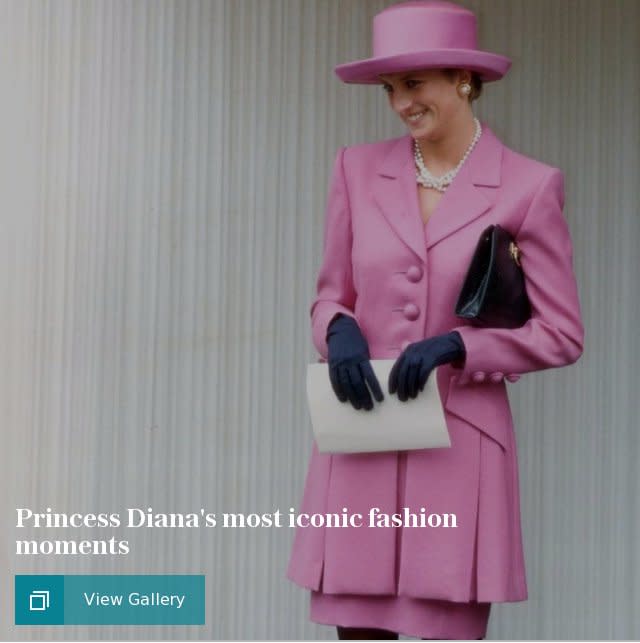
How did she meet Prince Charles?
Lady Diana met Prince Charles at Althorp in 1977; she was 16 and he was 29. The Prince was a member of a shooting party as a guest of Lady Diana's eldest sister, Lady Sarah. The Prince and Princess both recalled later that the meeting could be seen as the first landmark on the road to their marriage three and a half years later.
After Lady Diana spent a weekend at Balmoral as the guest of Prince Charles, a tabloid headline of 8 September 1980 proclaimed: "He's in Love Again". This sparked the press' obsession with Diana, which would follow her until her death.

Only a few months later, on 24 February 1981, Buckingham Palace announced: "It is with the greatest pleasure that the Queen and the Duke of Edinburgh announce the betrothal of their beloved son, the Prince of Wales, to the Lady Diana Spencer, daughter of the Earl Spencer and the Honourable Mrs Shand Kydd."
Diana's wedding to Prince Charles
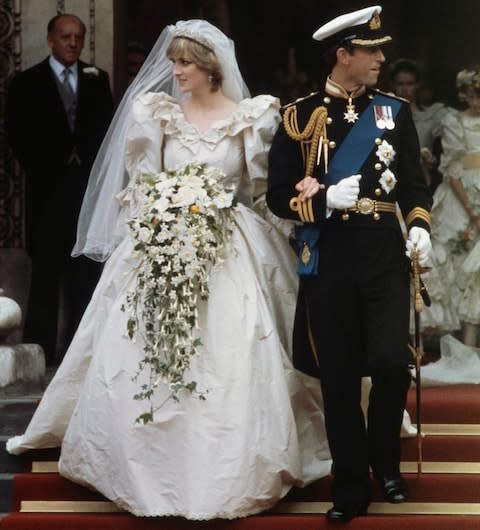
Charles and Diana married on July 29, 1981 at London's St Paul's Cathedral, three weeks after her 20th birthday.
The bride wore an Emanuel designed gown with 25ft train. Diana's nerves were clear to all - she mixed up the Prince's names calling him Philip Charles Arthur George instead of Charles Philip.
But that did not stop the Archbishop of Canterbury commenting that the marriage was "the stuff of which fairytales are made".
The wedding took place in front of a congregation of 2,500 and the largest worldwide television audience ever recorded at the time, some 750 million people.

What were her Royal duties?
As Princess of Wales, Diana undertook royal duties with Prince Charles on behalf of the Queen and represented her at functions around the world.
Famous for her charity work, she was president of Barnado's and London's Great Ormond Street Hospital; plus, her patronages included the British Red Cross, Headway, the British Deaf Association and Help the Aged, among others.
The Princess is also well known for her work with AIDS victims, children with Leukaemia and for the removal of landmines. One of the most enduring images of her was taken on a visit to Angola in 1997 where she was photographed walking through a minefield cleared by The Halo Trust charity.

The birth of her children, William and Harry
After their wedding, the royal couple took up residence at Kensington Palace and Highgrove House, near Tetbury and on 5 November 1981 they announced Diana was pregnant with their first child.
Born on 21 June 1982 in the private Lindo Wing of St Mary's Hospital in Paddington, their first son and heir was named Prince William Arthur Philip Louis. William's children George and Charlotte, who were born in 2013 and 2015, were both born in the same wing.

On 15 September 1984 Diana gave birth to their second son, Henry Charles Albert David - affectionately known by the Royal family and the public as Harry.
Diana was applauded as a refreshingly hands-on mother to the Royal children. She chose their nanny, schools and clothing, even taking them to school herself whenever she could.
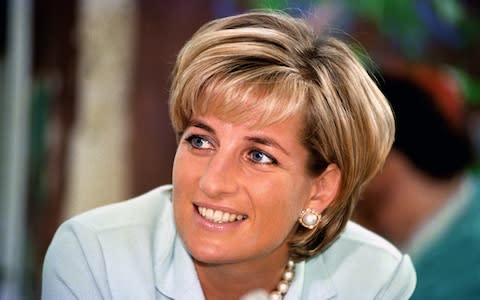
When did the marriage breakdown?
In December 1992, Prime Minister John Major announced the couple's "amicable separation" to the House of Commons, with Diana announcing her withdrawal from public life on 3 December 1993.
This didn't come as a surprise because by the late 1980s, Charles and Diana's separate lives had become public knowledge.
The Princess famously signalled that her marriage was over in 1992 when she posed for pictures alone outside India's Taj Mahal - regarded as the world's most romantic building - while on a royal visit with her husband.

When she was asked by the media what she had thought of the Taj Mahal, the Princess said: "It was a healing experience, very healing." Asked what she meant by that, she replied: "Work it out for yourself."
Two years after the separation, in November 1995, Diana took part in a famously open interview for the BBC current affairs show Panorama.
When asked about Prince Charles' affair with Camilla Parker Bowles - whom he met in 1971 and dated until 1973 - Diana famously quipped: "Well, there were three of us in this marriage, so it was a bit crowded."
She also cast doubt on the Prince's ability to rule, saying: "Because I know the character I would think that the top job, as I call it, would bring enormous limitations to him, and I don't know whether he could adapt to that."
Diana also confirmed her affair with James Hewitt, saying: "Yes, I adored him. Yes, I was in love with him. But I was very let down [by him]."

The Queen swiftly advised Prince Charles and Diana to divorce, sending both a letter just one month later, on 20 December.
In February 1996, Diana irritated the Queen by issuing her own announcement on the divorce, stating: "The Princess of Wales has agreed to Prince Charles's request for a divorce. The Princess will continue to be involved in all decisions relating to the children and will remain at Kensington Palace with offices in St James's Palace. The Princess of Wales will retain the title and be known as Diana, Princess of Wales."
The Palace quickly contradicted this statement, saying: "We can confirm that the Prince and Princess of Wales had a private meeting this afternoon at St James's Palace. At this meeting details of the divorce settlement and the Princess's future role were not discussed. All the details on these matters, including titles, remain to be discussed and settled. This will take time."
The couple officially divorced on 28 August 1996; while Diana did keep the title of Diana, Princess of Wales, she lost the Her Royal Highness title.
How did Princess Diana die?
Princess Diana died following a horrific car crash in Paris on August 31, 1997.
The 36-year-old princess was being driven at high speed in a Mercedes S-280 after she left the Ritz Hotel when the vehicle crashed into a pillar in a tunnel under the Alma bridge at around half-past midnight.
Diana, her then boyfriend Dodi Fayed, 41, son of Egyptian billionaire Mohamed Al-Fayed, the former owner of Harrods department store, and driver Henri Paul, all died in the late-night crash. Her bodyguard Trevor Rees-Jones survived.
Mr Paul and Mr Fayed died on the spot, while the princess died from her injuries in a nearby hospital a few hours later.
Investigations carried out by both French and British authorities concluded that Mr Paul was responsible for the crash. He was drunk and on anti-depressants when he lost control of the Mercedes as it sped through the tunnel that lies next to the River Seine, while trying to shake off paparazzi photographers.
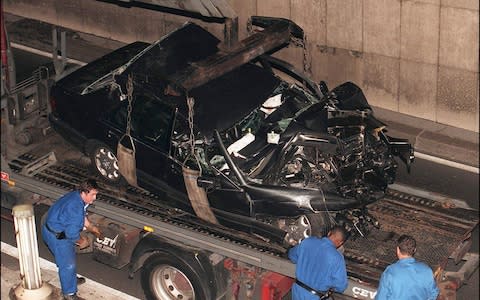
What happened at the inquest?
After six months of extraordinary claims and counter-claims from more than 250 witnesses, in April 2008 an inquest jury at the Royal Courts of Justice in London returned verdicts of unlawful killing for both the Princess and her boyfriend Dodi - the equivalent of manslaughter in a criminal court.
They said that the paparazzi who pursued the Princess's car and its driver Mr Paul were both to blame for the crash because of their "gross negligence".
The jury also concluded that the couple might have lived if they had worn seatbelts.

Conspiracy theories were rife
Conspiracy theories around Diana's death continued to circulate for years after her death. Here are some of the most persistent.
Diana's death was ordered by her family
Some of the most popular theories stem from the suggestion that Diana was pregnant with Dodi's child and the couple were about to get engaged. The story goes that the Royal Family could not bear the inevitable scandal - let alone the idea of Diana marrying a non-Christian. Therefore, one of the inevitable conclusions that has been drawn is that Diana's death was ordered by her own family.
MI6 was involved in her death
Richard Tomlinson was a former MI6 agent who was dismissed from the intelligence services and later served time in prison for breaching the Official Secrets Act 1989. Tomlinson alleged that agents had been monitoring Diana and that her death mirrored plans he saw in 1992 for the assassination of the President of Serbia. An inquiry was launched which eventually concluded that Tomlinson's claims were an embellishment.
Throughout the inquest, Mr Fayed, maintained that Diana and Dodi were "murdered" by MI6 on the orders of the Duke of Edinburgh.

Mysterious white Fiat Uno
Analysis of the wreckage of the Mercedes showed that it had come into contact with a white Fiat Uno, leaving traces of paint on the Mercedes bodywork. Mr Fayed alleged that the vehicle was used by the "security services" to block the road in front of the Mercedes, causing it to swerve and crash into the side of the tunnel. The vehicle was never found.
Lack of CCTV images
Mr Fayed stated in 2003 that there were about ten video cameras on the route taken by the Mercedes, including one on the entrance to the tunnel itself, but there are no recordings from any of these for the night in question. The Independent also stated in 2006 that there were more than 14 CCTV cameras in the Pont de l'Alma underpass, but none recorded footage of the fatal collision.

Seatbelts were sabotaged
Both Diana and Dodi were not restrained by their seatbelts at the time of the crash prompting some to suggest that they may have been sabotaged. French investigators declared all the seatbelts operational in 1998. Analysis of the wreckage of the car after its repatriation to England in 2005 found that all the seatbelts were in good working order bar Diana's, although it is thought that the damage took place after the accident.
Henri Paul's involvement
The fact that he actually died in the accident would seem to provide fairly conclusive evidence that he was not behind the crash, but according to conspiracy theorists Mr Paul was in the pay of a national security service. The main piece of evidence for this is supposedly the fact that he had a lot of cash on his person at the time of the car accident.

How did the Royal family react to her death?
The Queen was accused by some of a failure to capture the mood of the nation in the days following the death.
Public anger began as a result of the decision to issue an apparent "business-as-usual" message by taking Princes William and Harry to church at Balmoral, a few hours after Prince Charles had broken the news to them of their mother's death.
There were also accusations that the Queen remained in Scotland for too long, and did not return quickly enough to London, which had become the focal point for public grief over the Princess' death.
How did the nation react?
The national outpouring of grief following Diana's death was unprecedented.
Diana was the first genuine royal celebrity according to Andrew Marr, and her death shook the British in a way no other royal event in modern times has done.
On the day of her death, Tony Blair, still fresh in his job as Prime Minister, addressed the nation from outside St Mary Magdalene Church in Trimdon in his Sedgefield constituency.
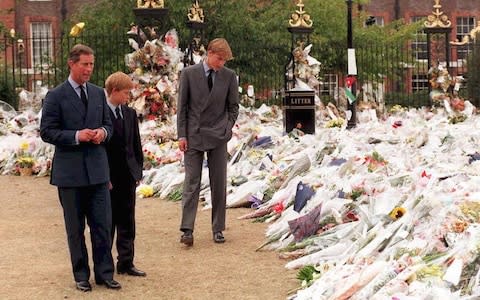
"She was the people’s princess and that’s how she will stay, how she will remain in our hearts and in our memories forever," Mr Blair declared.
The speech, scribbled by Mr Blair on the back of an envelope, following discussions with Alastair Campbell, his director of communications, was watched by millions and featured in the film The Queen.
In the days, weeks and months that followed, hundreds of thousands of mourners flocked to London to sign the book of condolence and to lay flowers outside Kensington Palace which became a place of pilgrimage.
Where was Diana's funeral?
The Princess's funeral was held at Westminster Abbey on 6 September 1997. Attended by 2,000 people, 32.10 million people watched the service in the UK and an estimated 2.5 billion people watched it worldwide.
William and Harry walked behind her coffin in the funeral procession, as well as the Prince of Wales, the Duke of Edinburgh, her brother Lord Spencer and representatives of some of her charities.
In an interview earlier this year, Harry discussed his memories of the funeral: "My mother had just died, and I had to walk a long way behind her coffin, surrounded by thousands of people watching me while millions more did on television. I don’t think any child should be asked to do that, under any circumstances. I don’t think it would happen today."
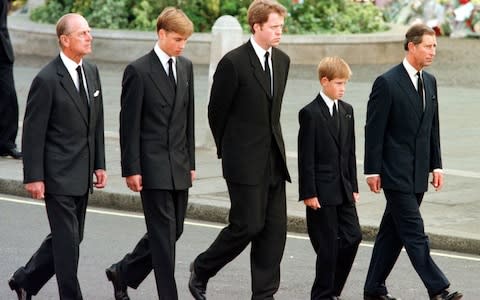
Elton John performed a re-written version of the song Candle in the Wind at the service as a tribute to the Princess.
Her brother Lord Spencer spoke at at the funeral, calling Diana "a very British girl who transcended nationality. Someone with a natural nobility who was classless and who proved in the last year that she needed no royal title to continue to generate her particular brand of magic."
Earlier this year, Prince Harry exclusively told the Daily Telegraph that he sought counselling after enduring two years of "total chaos" while still struggling in his late twenties to come to terms with the death of his mother.
He told Bryony Gordon that he had "shut down all his emotions" for almost two decades.
Where is Princess Diana buried?
Princess Diana is buried on an island in the Althorp Estate, the Spencer family home in Northamptonshire. A private burial took place at the estate following the funeral.
The estate is the main visitor attraction for those wanting to find out more Diana, although there are many other memorials to her, including The Diana, Princess of Wales Memorial Fountain in London's Hyde Park.
The Diana Princess of Wales Memorial Walk is a seven mile loop taking visitors through four of London’s parks: St James's Park; Green Park; Hyde Park; and Kensington Gardens.
The Diana, Princess of Wales Memorial Playground is located next to the Princess’ Kensington Palace home, and is tribute to her love of the innocence of childhood.

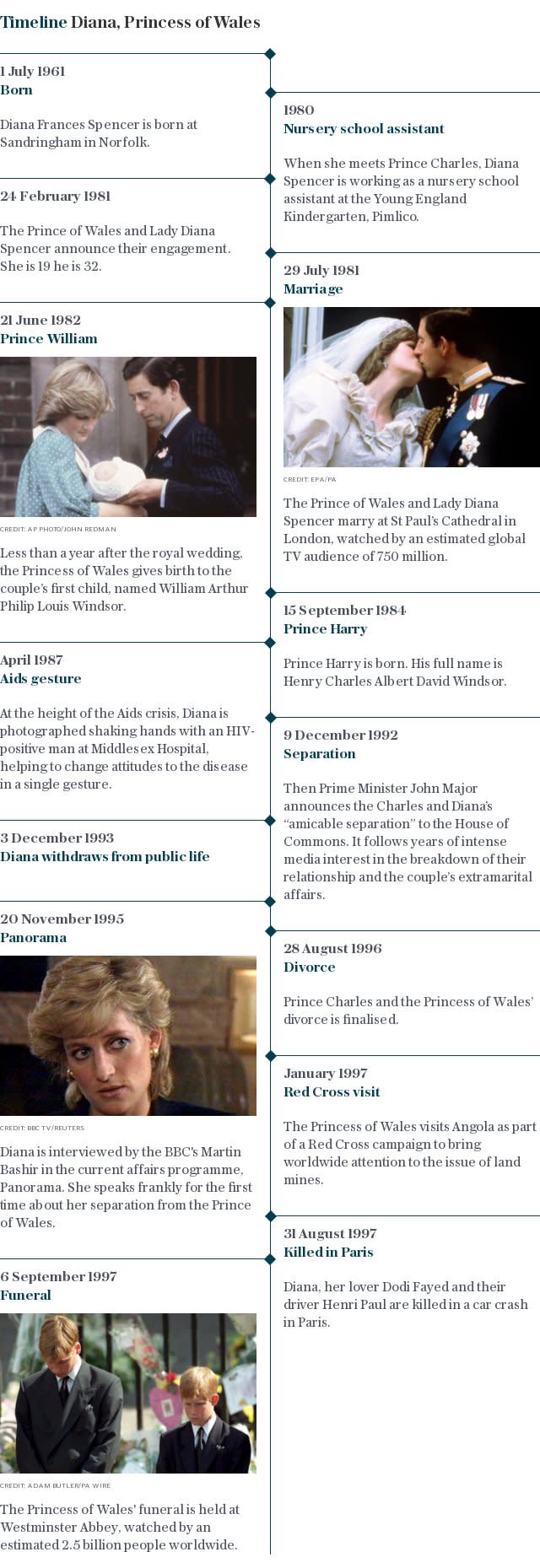

 Yahoo News
Yahoo News 
